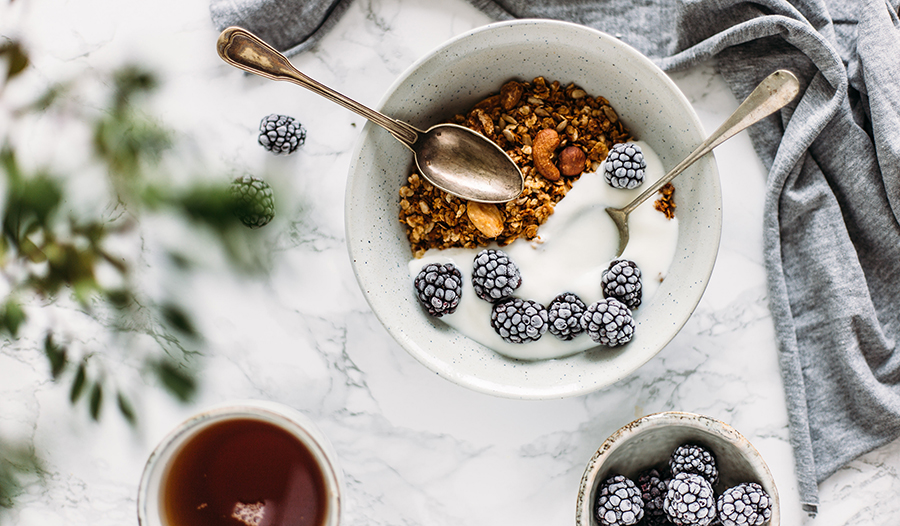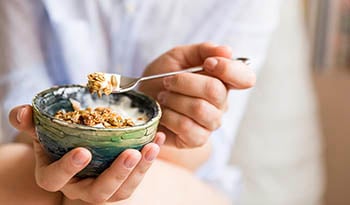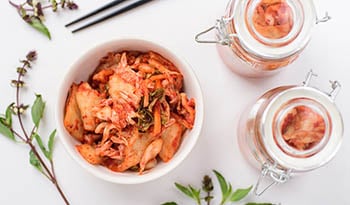5 Gut Health Tips: Stay Regular When Your Schedule Fluctuates
DISCLAIMER:This blog does not intend to provide diagnosis...
- In this article:
- A Healthy Microbiome is Key to Overall Health
- 1. Eat a “Clean” Diet
- 2. Hydrate with Water and Electrolytes
- 3. Supplement with Prebiotics and Probiotics
- 4. Get Enough Fiber
- 5. Add Fish Oil to Your Diet
- Take-Home Tips for Gut Health

We recognize that we feel better when we have consistent gastrointestinal elimination patterns, but do you realize that changing your daily regimen just a little can often stop this regularity?
With all the recent changes in the world affecting our life and work schedules, you may have less of a pattern in your eating, sleeping, exercise, and travel patterns. Your gut can be one of the first areas of the body to “protest” by displaying symptoms of constipation, diarrhea, bloating, belly aches, indigestion, and more.
Ideally, the healthiest stool pattern is the same time each day to optimize the elimination of your body’s waste. An individual who is constipated has less than three a week with difficulty passing stool.
It is important to acknowledge the first sign of constipation before it progresses into worsening abdominal pain and fatigue. Luckily, certain simple lifestyle habits and key supplements can help your bathroom trips become predictable again.
A Healthy Microbiome is Key to Overall Health
We all have our own microbiome — the world of living organisms currently inside your GI (gastrointestinal) tract. We depend on these bacteria and yeast to help us break down food, absorb and transport vitamins and minerals, strengthen our immune function, and lower our chances of food or chemical allergy.
Each of us houses billions of organisms that are essential to start the process of breaking down our food to make fuel. However, when we make unhealthy choices too often, bad bacteria and yeast multiply, usually leading to GI distress.
As more and more research unfolds, we are finding the presence of a healthy microbiome is one of the top predictors of maintaining health in the entire body.1 Think of these organisms as our “gatekeepers” that ward off inflammation. To find regularity and keep your immune system happy, support your gut microbiome with things that keep the “good” organisms thriving.
Below are easy methods to support a healthy microbiome.
1. Eat a “Clean” Diet
Your food and drink choices directly impact the growth of organisms inside you. Bad bacteria flourish when fed preservatives added to food, chemicals such as pesticide, processed carbohydrates, corn syrups, and refined sugar. If you have a diet of “food-like substances,” also known as processed and packaged food with low nutrient value, you help the bad guys have a party in your gut.
The common outcome is irregularity, bloating, and indigestion.
The good news is that if you support the billions of beneficial living organisms in your gut with clean eating, you help them thrive, and the bad guys start to die.
Clean eating is one of our most powerful weapons against disease in general, but what is it?
Foods that fuel a healthy gut:
- Vegetables and fruits grown naturally without pesticides
- Dairy and meat from animals that live an organic, low-stress life
- Fish caught in a wild habitat
- Specific healthy fats, such as fish oil, olive oil, and coconut oil to help absorb those foods
Foods that lead to an unhealthy gut:
- Food with added preservatives, fillers, dyes, and thickeners
- Plants sprayed with chemicals
- Processed foods like white flours, sugars, and corn syrups
- Packaged food because it almost always has 1, 2, and 3 above
When you find your bathroom habits changing, grab a rainbow of colored plants and some fish, and get to cookin’ to get movin’!
2. Hydrate with Water and Electrolytes
When your cells are thirsty, water is the only liquid they want and need. All the other cravings for sugary drinks are a result of being hungry or from the addictive taste of sugar. That is why almost all drinks except water are not considered healthy, with a few exceptions such as green tea or coconut water.
Your microbiome wants water as much as all the cells in your body. A growing amount of evidence shows that alkaline water may aid the growth of healthy bacteria in the gut.
In addition to water, our gut cells need electrolytes such as salt and potassium. Electrolytes aid peristalsis. Adding liquid or powder electrolytes to your water on hot, sweaty days is one of the best prevention measures for dehydration, fatigue, and constipation.
3. Supplement with Prebiotics and Probiotics
Ingesting both probiotics and prebiotics will help your gut microbiome stay balanced to perform its many duties. But, what are they, and how do you take them?
Probiotics are living microorganisms usually in the form of a supplement or food, such as yogurt, that are beneficial to our digestive tract. Probiotics consist of a variety of “good” bacteria or yeast that help your healthy gut microorganisms to flourish. Now that you are aware of your microbiome, ingesting probiotics is adding more healthy living organisms to the present ones in the gut.
You can load up on foods with probiotics such as organic coconut yogurt or fermented foods.
Another choice that ensures a more therapeutic dose is to take a probiotic supplement. If you are having significant gut symptoms, you may try a higher dose such as 50–100 billion CFU. Many of the products are in the million range and may be better for prevention, not treatment.2,3
Prebiotics are fiber-rich substances in food that induce the activity of beneficial bacteria and fungi in your microbiome.4,5 Examples include inulin, chicory root, Jerusalem artichoke, dandelion greens, acacia, and raw oats. These substances are the indigestible fiber that once eaten are used by the microbiome to induce fermentation and growth of new organisms.
In supplement form, a prebiotic often comes in the form of a powder, gummy, or chewable. Powders can be added to green juices or smoothies, or even water if you don’t mind the texture.
4. Get Enough Fiber
Most people in our modern society need more bulk in their diet in the form of high fiber foods and fiber additives. A goal for the intake of fiber is 25-40 grams and can be obtained in the forms of berries, leafy greens, apples, pears, avocados, beans, almonds, chia seeds, and flaxseed. Chia seeds and flaxseeds are best when ground to be partially absorbed into the body.
Soluble fiber in the form of psyllium capsules or acacia powder (double benefit of fiber and prebiotic) taken every night may be one of the best and effective remedies for constipation relief.6 Any fiber supplement must be taken with 8 ounces or more of water. Fiber works by bringing water into the colon, forming a bulking agent. If there is no water available, you may worsen constipation.
5. Add Fish Oil to Your Diet
The omega-3 fatty acids EPA and DHA are the beneficial oils found in certain types of fatty fish including salmon, tuna, mackerel, herring, and halibut. The American Heart Association suggests eating oily fish twice a week or more to get an adequate dose of omegas in the form of EPA and DHA (approximately 8 ounces of fish).
The overwhelming majority of people do not have enough fish oil in their diet and need to supplement instead. Fish oil intake has a significant role in digestive health by balancing the microbiome and lubricating the colon to help elimination. Research also shows that fish oil promotes heart health by lowering inflammatory particles in the coronary arteries.7
In my clinical experience, I have found many have difficulty taking fish oil supplements due to the taste of the oil or the after-effect of the fish oil taste revisiting you about 30 minutes after supplementation (also known as fish burps). This is easily prevented with two measures. Keep your fish oil in the freezer and take it in the middle of a meal. Food and water help the oil go down well, and the chill keeps any pungent taste away.
Take-Home Tips for Gut Health
- Try to stay on a schedule each day despite the many changes.
- Eat clean food instead of “food-like substances.”
- Drink water with or without added electrolytes as your primary source of hydration.
- Focus on foods high in fiber like plants, oily fish, and fermented foods.
- Supplement if needed with probiotics, prebiotics, fiber, and fish oil.
References:
- Silbergeld EK. The Microbiome. Toxicol Pathol. 2017;45(1):190-194.
- Islam SU. Clinical Uses of Probiotics. Medicine (Baltimore). 2016;95(5).
- Probiotics: In depth. National Center for Complementary and Alternative Medicine. Accessed May 7, 2018. https://www.nccih.nih.gov/health/probiotics-what-you-need-to-know
- Lamsal, Buddhi P (15 August 2012). "Production, health aspects and potential food uses of dairy prebiotic galactooligosaccharides". Journal of the Science of Food and Agriculture. 92(10):2020-2028.
- Zaman, Siti A., Sarbini, Shahrul R. (7 July 2015). "The potential of resistant starch as a prebiotic" (PDF). Critical Reviews in Biotechnology. 36(3):578-84.
- Quitadamo P, Coccorullo P, Giannetti E, et al. A randomized, prospective, comparison study of a mixture of acacia fiber, psyllium fiber, and fructose vs polyethylene glycol 3350 with electrolytes for the treatment of chronic functional constipation in childhood [published correction appears in J Pediatr. 2012 Dec;161(6):1180.]
- Jain AP, Aggarwal KK, Zhang PY. Omega-3 fatty acids and cardiovascular disease. Eur Rev Med Pharmacol Sci. 2015;19(3):441-445.

 By Dr. Nicole Craven, M.D.
By Dr. Nicole Craven, M.D.


